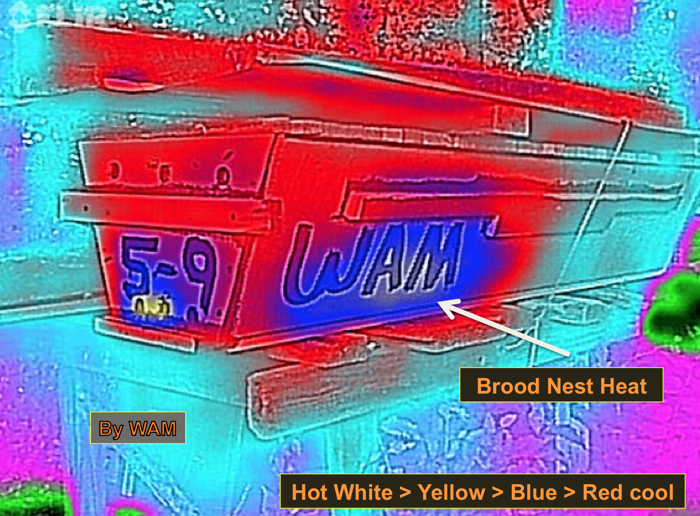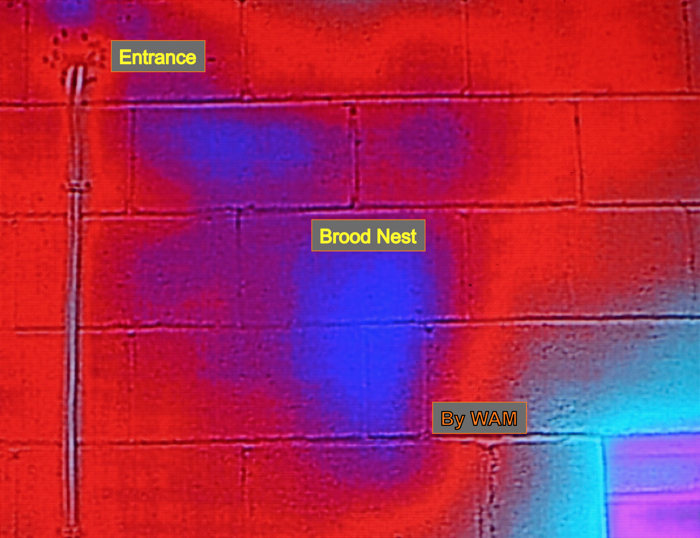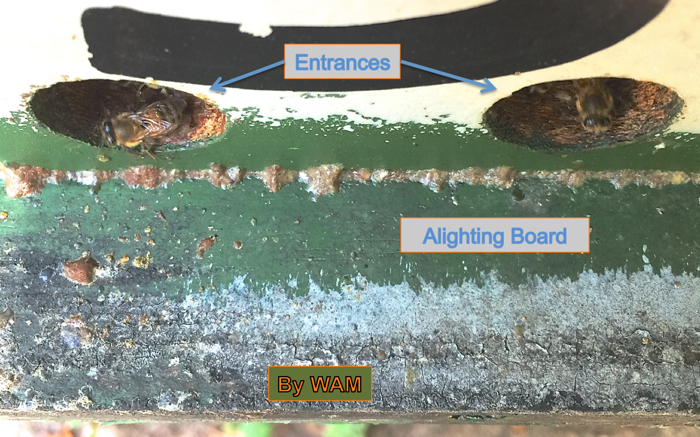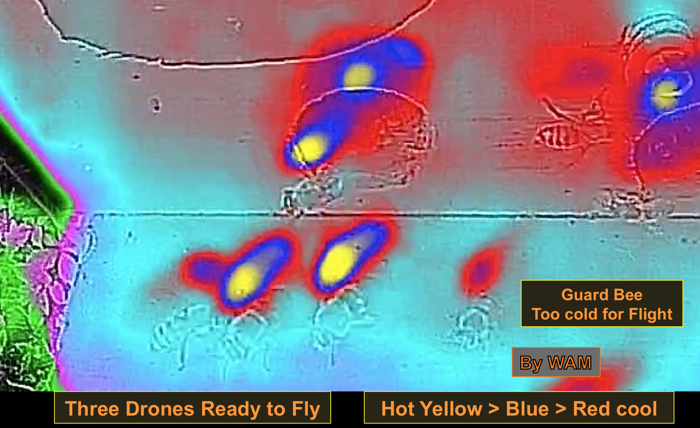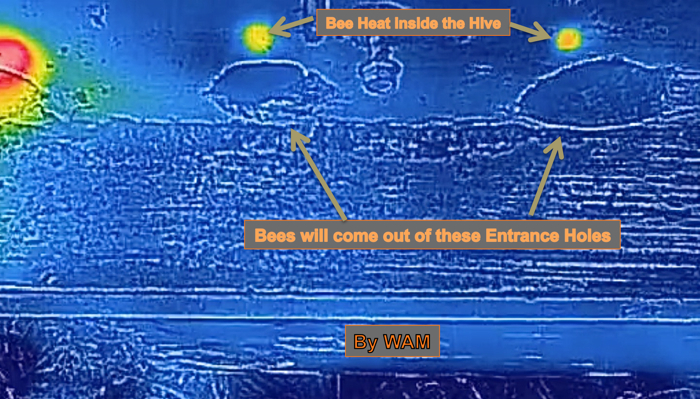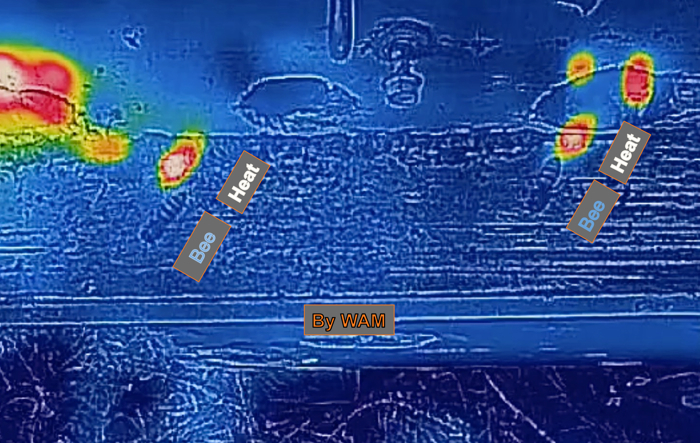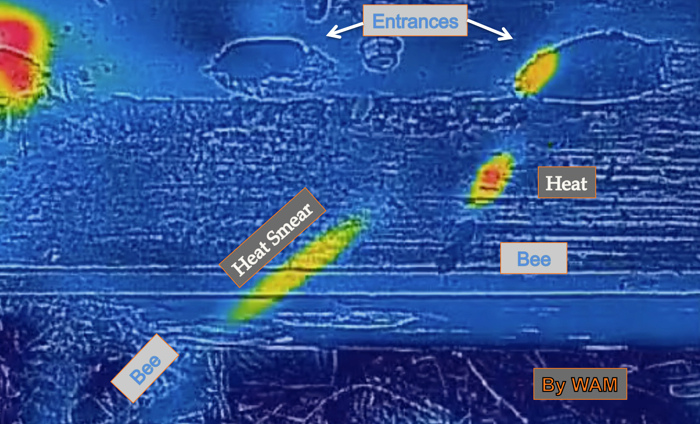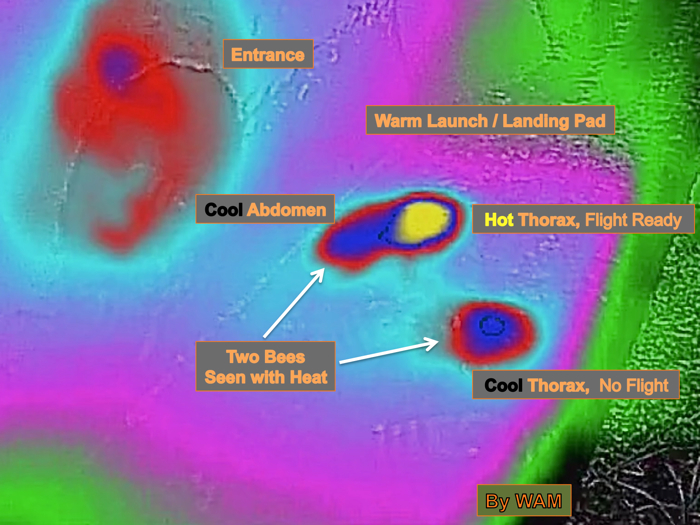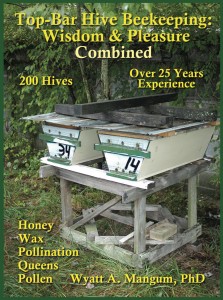Hot Bees
Hot Bees in Top Bar Hives
Camera Technology by Flir
We see bees in visible light, comprising the colors of the rainbow. Another way to observe bees and top bar hives is with heat, where colors represent different levels of heat as shown below.
The heat is coming from the brood nest of the top bar hive, in blue, which is closer to the entrance end of the hive. Notice the two yellow active entrances appear extra hot (yellow warmer than blue) because the heat does not come through the wood. Red is cooler than blue. The red is away from the heat enter of the brood nest. The metal cover is slightly warmer (red) from brood nest heat below. The metal roof is cooler at the back of the hive where the bees store their honey, apprearing in green.
A thermal camera can find a feral colony in a building, saving on incorrectly tearing open a building in the wrong place trying to find the bees. Here is a feral colony in a cinder block wall of a building. The entrance is at the upper left, where the pipe running up the wall turned and went through. The black dots are bees around the entrance. Blue is the brood nest as marked. The weaker blue, between the entrance and the brood nest location, might be honey storage combs.
Now let’s move to observing the hot and cooler bees at the hive entrances. First here are a couple of lower top bar hive entrances in regular visible light for comparison with the other thermal pictures below.
A Thermal Image and a Video of Drones Flying from Top Bar Hives
Below is a thermal image of a top-bar hive alighting board. The main bees here are the drones. Above each one is the heat signature of their flight muscles recorded in yellow, the hottest in this scale, indicating ready to fly. Bees must have their flight muscles hot enough to fly. The heat scale here is: yellow is hot, then blue getting cooler, followed by red, and green. The worker bee to the right has a cooler thorax at red, not preheated, too cool to fly. Those bees just run around excitedly on the alighting board, but I know they are not flying off.
Here is a movie clip of the scene above showing drones taking mating flights. The clip starts in black and white then changes to color. In black and white, the heat signatures are just ghost white dots above the bees. In color, the vivid yellow means fly, and red means not flying. Blue means a cool abdomen.
Thermal Images and a Video of Workers Flying from a Top Bar Hive
Below worker bees, still inside the hive, can be seen through the wood. The heat from their preheated flight muscles appeared before they exited the entrance hole. Bees preparing for flight can become hotter than inside the hive. Their yellow heat signatures came through the hive first. Then the bees left from the entrance. The bees were flying out on a cool morning.
Note this color scale is different from the one above. Here white is hotter than red, and red hotter than yellow, and the blue background is the coolest. With the thermal camera you pick the color scale that best bring out the details. Here the yellow warmth from the fast flying bees shows a high contrast with the dark blue.
Below the worker bees launched into flight. Both bees were flying, but they were still over the alighting board.
Below, yellow warmth has trailed after the bees. For the left bee, her heat signature has smeared out as she sped up more than the bee on the right. The bee on the right has just passed over the edge of the alighting board.
Below is a movie clip of the scene above, showing worker bees leaving preheated on a cool morning. Their flight muscles must stay hot or the bees cannot fly.
Below, a warm welcome home. The side shot of a bee’s heat signature, ready to launch, shows better the localized round hot yellow dot from her thorax. The blue lobe to the left is the bee’s abdomen, which is cooler. At this point in the launch, her head is also cool, but I suppose too small to record a signature. The blue bee out near the edge of the alighting board is not hot enough to fly. Notice the local area in front of this entrance hole is warmer than the cooler (green) surroundings. The bees have a slightly warmer launch and return pad. It does not happen all the time and might only be a side effect of the ventilation airflow through my entrance holes.
More thermal pictures and movie clips are coming as I get the technical side to work with the honey bee biology side.
You can support this work by purchasing a copy of my book. Please do not copy the graphic content of my website as I hold the copyrights. If you want to use the above graphics by streaming them to your meeting site for a presentation, consider buying a copy of my book as a fair trade. I formally agree to that exchange. Other beekeepers have done that swap, and it worked quite well. I have a very dependable web page host. If you have questions about linking your meeting site to my web page, use the contact email form at the bottom of the book-ordering page. To get to that page quickly, click on the book picture below.
Consider supporting these pages by making a donation. Click the donation button below and enter credit card or debit card information. Paypal handles all the security. Thank you.
W. A. Mangum, PhD
